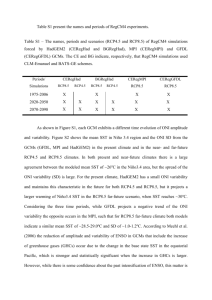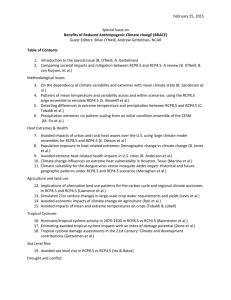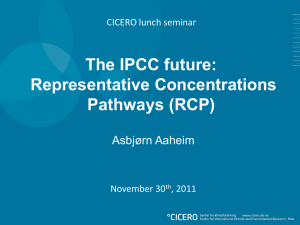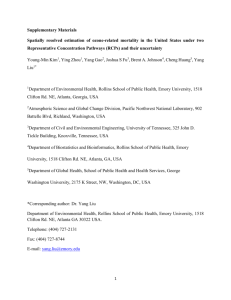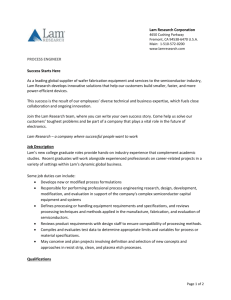Using climate projections for analyses of economic impacts and their social implications
advertisement
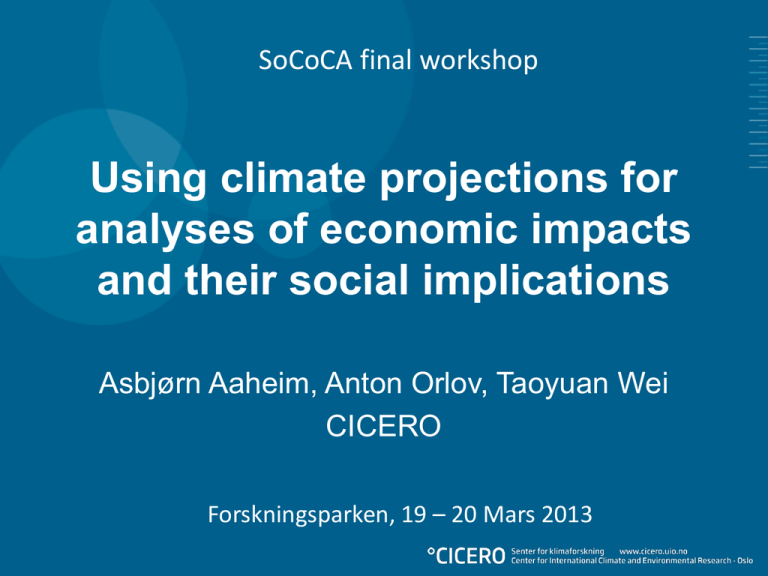
SoCoCA final workshop Using climate projections for analyses of economic impacts and their social implications Asbjørn Aaheim, Anton Orlov, Taoyuan Wei CICERO Forskningsparken, 19 – 20 Mars 2013 Levels of modeling, information and knowledge Information: Global patterns and long-term trends Decisions: Position in negotiations Information: Country aggregates for socioeconomic and climate indicators Decisions: Regulations, incentives Information: Learning from others and personal experiences Decisions: Actions Global - GCM National - RegCM Local – RegCM Hydrological Economic sectors and impacts of climate change in GRACE A model for Global Responses to Anthropogenically driven Changes in the Environment Sector Specific impacts Agriculture Productivity of soil Forestry Growth of biomass Fisheries Size of of stocks General impacts Crude oil Coal Demand Refined oil Demand Electricity Demand Gas Demand Iron and steel Capital stock: Sea-level rise Extreme events Labour supply: Health effects Non-metallic minerals Other manufacturing Air transport Tourist demand Sea transport Tourist demand Other transport Tourist demand Other services Tourist demand Direct impacts in agriculture +2.5 oC global mean Impact functions for agriculture by world region Calibrated by estimates of direct impacts in region at an increase in global mean temperature of +2.5 °C 0,0800 0,0600 0,0400 Rate of change Based on the same functional relationship as for Europe 0,1000 0,0200 0,0000 -0,0200 -0,0400 -0,0600 -0,0800 -0,1000 EU WEU EEU FSU MEA AFR SAS EAS PAS PAO NAM LAM (ref) 0,300 WEU 0,200 EEU 0,100 FSU 0,000 MEA AFR -0,100 Calibration Calculate the EU impact with the regional climate reference SAS -0,200 EAS PAS -0,300 PAO -0,400 NAM LAM -0,500 0,0 0,5 1,0 1,5 2,0 2,5 3,0 3,5 4,0 4,5 5,0 5,5 6,0 Scale each parameter linearly to the «observed» regional impact Keep the signs of dT and dP as in EU The global scenarios: CO2 emissions in the RCP scenarios 35 30 PgC/year 25 20 MiniCAM - RCP 4.5 MESSAGE - RCP 8.5 15 10 5 0 2000 2005 2010 2020 2030 2040 2050 2060 2070 2080 2090 2100 Temperature change (°C) and percent change in annual precipitation at RCP4.5 and RCP8.5 Forested land Populated areas 8,0 8,0 8,0 7,0 7,0 7,0 6,0 6,0 6,0 5,0 5,0 4,0 RCP8.5 5,0 4,0 3,0 3,0 2,0 2,0 1,0 1,0 0,0 0,0 RCP4.5 Celcius RCP4.5 Celcius Celcius Crop land RCP4.5 4,0 RCP8.5 RCP8.5 3,0 2,0 1,0 WEU EEU FSU MEA AFR SAS EAS PAS PAO NAM LAM WEU EEU FSU MEA AFR SAS EAS PAS PAO NAM LAM 0,0 Axis Title Forested land Populated areas 20,0 20,0 10,0 10,0 10,0 0,0 0,0 0,0 RCP4.5 -10,0 RCP8.5 -20,0 -30,0 -40,0 WEU EEU FSU MEA AFR SAS EAS PAS PAO NAM LAM RCP4.5 -10,0 RCP8.5 Percent 20,0 Percent Percent Crop land WEU EEU FSU MEA AFR SAS EAS PAS PAO NAM LAM RCP8.5 -20,0 -20,0 -30,0 -30,0 -40,0 RCP4.5 -10,0 -40,0 WEU EEU FSU MEA AFR SAS EAS PAS PAO NAM LAM WEU EEU FSU MEA AFR SAS EAS PAS PAO NAM LAM Annual increase in permit prices: 12 – 18 percent 2098 2095 2092 2089 2086 2083 2080 2077 2074 2071 2068 2065 2062 2059 2056 2053 2050 2047 2044 2041 2038 2035 2032 2029 2026 2023 2020 2017 2014 2011 2008 2005 Global costs of cutting emissions - 1000 US$/tC 2,5 2 1,5 1 0,5 0 Economic impacts of climate change. 1000 trill. US$ PPP. 1,00 1,00 0,00 0,00 AFR -1,00 LAM MEA -2,00 PAO -1,00 WEU AFR -2,00 PAS -3,00 SAS -4,00 EAS FSU -5,00 LAM -3,00 MEA -4,00 PAS SAS -5,00 EEU -6,00 -7,00 NAM PAO -6,00 EAS WEU -7,00 FSU EEU -9,00 -9,00 2004 2009 2014 2019 2024 2029 2034 2039 2044 2049 2054 2059 2064 2069 2074 2079 2084 2089 2094 2099 -8,00 RCP8.5 2004 2008 2012 2016 2020 2024 2028 2032 2036 2040 2044 2048 2052 2056 2060 2064 2068 2072 2076 2080 2084 2088 2092 2096 2100 NAM -8,00 RCP4.5 2100 2097 2094 2091 2088 2085 2082 2079 2076 2073 2070 2067 2064 2061 2058 2055 2052 2049 2046 2043 2040 2037 2034 2031 2028 2025 2022 2019 2016 2013 2010 2007 2004 Trill. US$ Change in global value added (GDP) by reducing emissions from RCP8.5 path to RCP4.5 path 1,00 0,00 -1,00 -2,00 -3,00 -4,00 -5,00 -6,00 -7,00 -8,00 -9,00 Sub-Saharian Africa Temperature increase by emission scenaiero and land category in Sub-Saharian Africa (from 2006) 6 5 RCP4.5 3 RCP8.5 2 1 0 Crop Forest Population Increase in precipitation in by emission scenario and land category in Sub-Saharian Africa (from 2006) 8% 7% 6% 5% Percent +°C 4 4% 3% RCP4.5 2% RCP8.5 1% 0% -1% -2% Crop Forest Population 2004 2007 2010 2013 2016 2019 2022 2025 2028 2031 2034 2037 2040 2043 2046 2049 2052 2055 2058 2061 2064 2067 2070 2073 2076 2079 2082 2085 2088 2091 2094 2097 2100 Trillion US$ (2004) GDP for Africa 14 12 10 8 RCP8.5_CC 6 RCP4.5_CC 4 2 0 Costs of reducing emission pathway from RCP8.5 to RCP4.5 for Africa south of Sahara Change in value added by sector 1400,0 1200,0 1000,0 Trill. US$ 800,0 600,0 400,0 200,0 0,0 -200,0 -400,0 Alternative measures for the impacts of changing path from RCP4.5 to RCP8.5 on agriculture in 2100 20,0 15,0 10,0 5,0 Percent change 0,0 -5,0 Direct impacts Volumes -10,0 Value added -15,0 -20,0 -25,0 -30,0 -35,0 WEU CEE FSU MEA AFR SAS EAS PAS PAO NAM LAM From national economies to livelihood of small-holders Most small farmers produce what they need, not what they can sell in markets Income from work off the farm may help farmers improve their standards of living In the tems of an economist: the budget constraint changes from: Income from production = total consumption and savings to: Food consumed from own farm + income from sales + wages = Total consumption of food + consumption of other goods The size of farms matters Approximation of farms by size in Malawi 0,09 0,08 0,07 Frequency 0,06 0,05 0,04 0,03 0,02 0,01 0 0,0 0,1 0,2 0,3 0,4 0,5 0,6 0,7 0,8 0,9 1,0 1,1 1,2 1,3 1,4 1,5 1,6 1,7 1,8 1,9 2,0 2,1 2,2 2,3 2,4 2,5 2,6 2,7 2,8 2,9 3,0 3,1 3,2 3,3 3,4 3,5 3,6 3,7 3,8 3,9 Farm size (ha) Small: Poor: Consumption Consumption constrained by subject to nutrition limit yield on own farm Large: Income from production = expenditures Preliminary comparisons Climate impacts (RCP8.5 vs RCP 4.5 for Africa south of Sahara): Productivity of soil in arable land: Down 17.5 percent Price of agricultural products: Up 14.9 percent Wage effect: Climate impacts plus 5 % reduction of expected income from other sources Case Small farms Poor farms Largest farm People - change from base Largest farm People - change from base Base 2.93 ha - 0.855 - Climate impacts 1.95 ha -1 196 000 0.865 78 000 Wage effect 1.75 ha -2 546 000 0.875 156 000 Yield 0,7000 0,6000 0,4000 Base 0,3000 impacts Wage effect 0,2000 0,1000 Percent work on farm 90,0 80,0 70,0 60,0 50,0 Base 40,0 impacts 30,0 Wage effect 20,0 10,0 ha 3,5 3,3 3,1 2,9 2,7 2,5 2,3 2,1 1,9 1,7 1,5 1,3 0,0 1,1 ha 100,0 0,9 0,0000 0,9 1,05 1,2 1,35 1,5 1,65 1,8 1,95 2,1 2,25 2,4 2,55 2,7 2,85 3 3,15 3,3 3,45 MKW 0,5000 Share of food provided from own farm 0,8 0,7 0,6 Base 0,4 Impacts Wage effect 0,3 0,2 0,1 ha 3,5 3,4 3,3 3,2 3,1 3 2,9 2,8 2,7 2,6 2,5 2,4 2,3 2,2 2,1 2 1,9 1,8 1,7 1,6 1,5 1,4 1,3 1,2 1,1 1 0 0,9 Share 0,5 Consumption of food 0,5900 0,5400 0,4400 Base 0,3900 impacts Wage effect 0,3400 0,2900 Consumption of other goods 0,2400 0,9 1,05 1,2 1,35 1,5 1,65 1,8 1,95 2,1 2,25 2,4 2,55 2,7 2,85 3 3,15 3,3 3,45 0,1300 ha 0,1250 0,1200 0,1150 0,1100 0,1050 Base 0,1000 impacts 0,0950 Wage effect 0,0900 0,0850 0,0800 0,9 1,05 1,2 1,35 1,5 1,65 1,8 1,95 2,1 2,25 2,4 2,55 2,7 2,85 3 3,15 3,3 3,45 MkW MKW 0,4900 ha That’s all for now Thank you!
